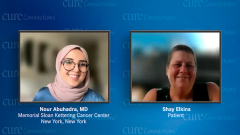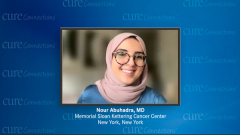
Background on Metastatic Triple Negative Breast Cancer
Dr Nour Abahadra of Memorial Sloan Kettering discusses the diagnosis, treatment, and management of metastatic triple negative breast cancer (TNBC). Patient guest, Shay Elkins, shares her experience, from discovering a rapidly growing tumor to navigating her diagnosis and treatment, highlighting the importance of personalized support and resources available online.
Episodes in this series

Dr Nour Abahadra: Hello and welcome to this CURE® Connections video series titled, “Metastatic Triple Negative Breast Cancer: Overcoming Challenges in Diagnosis Treatment and Management”. I'm Dr Nour Abahadra. I work at Memorial Sloan Kettering. I'm an assistant attending. I also have roles as the co-section head of our Triple Negative Breast Cancer Clinical Trial Portfolio and I'm also the co-director of our Rare Breast Cancer Program. And joining me today in the discussion are Denise Anthony, a registered nurse at Memorial Sloan Kettering Cancer Center and our guest patient Shay Elkins. And today we're going to discuss a number of topics pertaining to the care of patients with Metastatic Triple Negative Breast Cancer or TMBC. So, let's get our first topic started.
The first is background on Metastatic Triple Negative Breast Cancer. So, at first I'll kind of just kick things off by going over what makes breast cancer triple negative. So by way of background this is a subtype of breast cancer that comprises about 15% of all breast cancers and that accounts to about 200,000 new diagnoses a year.
And this subtype is biologically aggressive with a higher risk of early relapse compared to some other subtypes of breast cancer. And in terms of the biology of triple negative breast cancer, we know that it's driven by alternative pathways than those that are activated in hormone receptor positive or HER2 positive breast cancer. And essentially the definition comes down to it having zero expression or less than 1% expression of estrogen receptor, the same for progesterone receptor and then no HER2 expression. Although we'll touch a little bit later about how the definition of triple negative breast cancer is evolving. And so, because of that it's not as sensitive to hormone targeted therapies or HER2 targeted therapies in general and instead kind of the backbone of our therapy includes chemotherapy, sometimes immunotherapy, and then we're developing more and more targeted therapies that we'll talk about as well.
We've touched a little bit about how common it is. The typical patient with triple negative breast cancer, unfortunately you know this is a breast cancer that is commonly diagnosed in younger women. Generally, we see that in women under the age of 40 have a higher risk of developing triple negative breast cancer. As far as kind of other demographics to consider, we've also seen that triple negative breast cancer affects black women more commonly than white women. And then family history is an important one here by way of kind of germline hereditary causes. We know that triple negative breast cancer is linked to BRCA1, BRCA2, as well as some other similar germline mutations.
And you know historically as far as the general prognosis for patients with metastatic triple negative breast cancer, you'll see things quoted that vary between six months to two years. Although I always caution my patients to say that this is kind of demographic and prognosis data that was collected in a time that preceded a lot of the newer medications that we have. And we'll kind of go over some of those new medications and some of the outcomes that we're seeing with new treatments like immunotherapy and antibody drug conjugates.
Dr Nour Abahadra: So I want to kind of shift the conversation now to Shay and kind of hear a little bit about your journey and your diagnosis. Did you have metastatic disease at diagnosis or did you progress from earlier stage?
Shay Elkins: I did not have metastatic when I was diagnosed. I was diagnosed stage three because of the size of my tumor.
Dr Nour Abahadra: Got it. And what symptoms were you having at the time of diagnosis?
Shay Elkins: All I had was just the I felt the tumor in my breast. I had had a testing in January. I had had a mammogram in January. I felt the lump in June. And by the time I got to see my doctor in July, it was the size of an egg. Like that's how quickly it had grown. So, it was progressing very quickly.
Dr Nour Abahadra: My gosh, that must have been such a difficult time for you. I always talk to so many of my patients. I feel like the worst time almost is that window before you have a plan set in place. Things are happening still. It's growing and you feel like just so up in the air. I'm sorry, you had to go through that. So, you mentioned the mammogram that you'd had. I guess the screening mammogram that was in January, but then additional imaging in around July. What other testing did you have done?
Shay Elkins: Just the regular testing by my doctor. She felt the tumor. So she sent me right away. Once I did, they did another mammogram. And then we did a sonogram. And then they did a biopsy pretty quickly after that.
Dr Nour Abahadra: And any other tests that they did, kind of like genetic testing at that point?
Shay Elkins: They did. Once it came back positive for triple negative, they started the genetic testing right away.
Dr Nour Abahadra: Okay. And was your genetic testing positive or came back clear?
Shay Elkins: It was all negative.
Dr Nour Abahadra: Okay. And what kind of went through your mind after your diagnosis?
Shay Elkins: I think I just tried to stay very positive. I was scared, obviously. I've got children. I've got grandchildren. So my husband, everyone, it was my worry was about leaving them. I think that was my biggest thing. But I think I stayed more positive because I was like, there's so many treatments. There's so many things like I'm absolutely not giving up. So we just kept moving forward and kept trying to stay positive.
Dr Nour Abahadra: So that's incredible. It's so hard, especially at that moment of diagnosis and seeing what’s out there on the internet in particular about triple negative. So that's a huge testament to you and your strength that you were able to maintain that positivity, especially in the beginning, kind of, you know, it's a whirlwind.
Shay Elkins: Yes, I learned pretty quickly not to Google. Yeah. So that's so funny you say that. I have a Google ban in my clinic. I say, if you have any questions, just ask me, but do not Google it.
Dr Nour Abahadra: Did you kind of these feelings that they were rushing through you? Did you feel like you could communicate that to your support system, your caregiver, or was that something you kind of kept inside?
Shay Elkins: No, because I think they were trying to be as positive as I was. So I think it was good for us to talk about it and just keep it all out there so that we were supporting each other and they were being there for me as well. That's amazing. You mentioned that you try to avoid Google.
Dr Nour Abahadra:Was there any kind of like helpful educational websites or materials that you still kind of stumbled on or?
Shay Elkins: Not really. I realized pretty quickly that I needed more of someone that was like person to person. So, you know, my center had some, you know, support systems, some navigators, things like that, that I more relied on them for information than I did Google.






